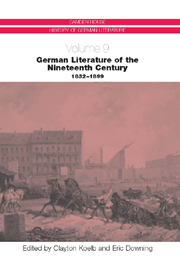Book contents
- Frontmatter
- Contents
- Illustrations
- Introduction
- Part I Contexts
- Part II Movements
- Literary Controversy: Naming and Framing the Post-Romantic, Pre-Realist Period
- Poetic Realism, Naturalism, and the Rise of the Novella
- Literary Movements of the 1890s: Impressionism, Symbolism, and fin-de-siècle Austria
- Part III Genres
- Part IV Bibliographical Resources
- List of Primary Sources
- Selected Secondary Works Cited
- Notes on the Contributors
- Index
Literary Controversy: Naming and Framing the Post-Romantic, Pre-Realist Period
from Part II - Movements
Published online by Cambridge University Press: 05 February 2013
- Frontmatter
- Contents
- Illustrations
- Introduction
- Part I Contexts
- Part II Movements
- Literary Controversy: Naming and Framing the Post-Romantic, Pre-Realist Period
- Poetic Realism, Naturalism, and the Rise of the Novella
- Literary Movements of the 1890s: Impressionism, Symbolism, and fin-de-siècle Austria
- Part III Genres
- Part IV Bibliographical Resources
- List of Primary Sources
- Selected Secondary Works Cited
- Notes on the Contributors
- Index
Summary
How do we define the periods of German literature? In traditional literary histories the labels assigned to periods by former generations of German scholars include an odd assortment of features. The sixteenth and seventeenth centuries, for example, which are usually taught under the tripartite designation Renaissance-Reformation-Baroque, mix movements that were originally associated with architecture and art history (Renaissance and Baroque) outside German borders with a religious movement identified primarily with a native revolt against the Roman-Catholic church. Although each of these terms may describe some characteristics of the literary production of the early modern era, none relates specifically to literature; they are drawn from a more general view of ideological currents and applied then to specific works of poetry, prose, or drama. Similarly the Enlightenment as a period in German letters occurring primarily in the eighteenth century describes a larger intellectual tendency, one that was extremely broad and not shared in all of its particulars by the writers whose works are subsumed under that rubric. With the “Storm and Stress” (Sturm und Drang) we encounter for the first time in the post-medieval era a label that was developed for, as well as from, the literary sphere. As a period, however, the Storm and Stress encompasses only a small clique of writers publishing during the seventh and eighth decades of the eighteenth century and describes a mood of rebellion connected with a younger generation; authors whose works are not included in this period designation are either missing from literary history or shoe-horned into another period that overlaps with the Storm and Stress.
- Type
- Chapter
- Information
- German Literature of the Nineteenth Century, 1832–1899 , pp. 93 - 116Publisher: Boydell & BrewerPrint publication year: 2005



